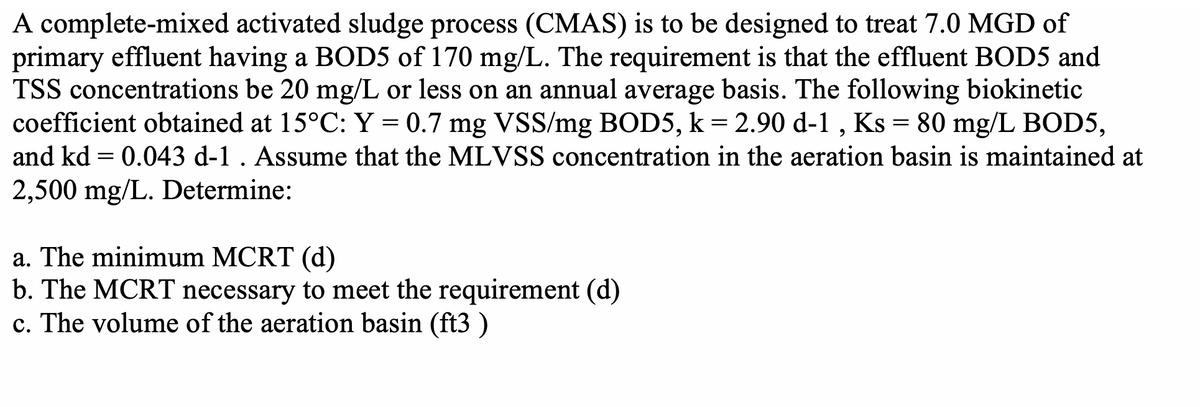A complete-mixed activated sludge process (CMAS) is to be designed to treat 7.0 MGD of primary effluent having a BOD5 of 170 mg/L. The requirement is that the effluent BOD5 and TSS concentrations be 20 mg/L or less on an annual average basis. The following biokinetic coefficient obtained at 15°C: Y = 0.7 mg VSS/mg BOD5, k = 2.90 d-1, Ks = 80 mg/L BOD5, and kd= 0.043 d-1 . Assume that the MLVSS concentration in the aeration basin is maintained at 2,500 mg/L. Determine: a. The minimum MCRT (d) b. The MCRT necessary to meet the requirement (d) c. The volume of the aeration basin (ft3)
A complete-mixed activated sludge process (CMAS) is to be designed to treat 7.0 MGD of primary effluent having a BOD5 of 170 mg/L. The requirement is that the effluent BOD5 and TSS concentrations be 20 mg/L or less on an annual average basis. The following biokinetic coefficient obtained at 15°C: Y = 0.7 mg VSS/mg BOD5, k = 2.90 d-1, Ks = 80 mg/L BOD5, and kd= 0.043 d-1 . Assume that the MLVSS concentration in the aeration basin is maintained at 2,500 mg/L. Determine: a. The minimum MCRT (d) b. The MCRT necessary to meet the requirement (d) c. The volume of the aeration basin (ft3)
Introduction to Chemical Engineering Thermodynamics
8th Edition
ISBN:9781259696527
Author:J.M. Smith Termodinamica en ingenieria quimica, Hendrick C Van Ness, Michael Abbott, Mark Swihart
Publisher:J.M. Smith Termodinamica en ingenieria quimica, Hendrick C Van Ness, Michael Abbott, Mark Swihart
Chapter1: Introduction
Section: Chapter Questions
Problem 1.1P
Related questions
Question

Transcribed Image Text:A complete-mixed activated sludge process (CMAS) is to be designed to treat 7.0 MGD of
primary effluent having a BOD5 of 170 mg/L. The requirement is that the effluent BOD5 and
TSS concentrations be 20 mg/L or less on an annual average basis. The following biokinetic
coefficient obtained at 15°C: Y = 0.7 mg VSS/mg BOD5, k = 2.90 d-1, Ks = 80 mg/L BOD5,
and kd = 0.043 d-1. Assume that the MLVSS concentration in the aeration basin is maintained at
2,500 mg/L. Determine:
a. The minimum MCRT (d)
b. The MCRT necessary to meet the requirement (d)
c. The volume of the aeration basin (ft3)
Expert Solution
This question has been solved!
Explore an expertly crafted, step-by-step solution for a thorough understanding of key concepts.
Step by step
Solved in 5 steps

Recommended textbooks for you

Introduction to Chemical Engineering Thermodynami…
Chemical Engineering
ISBN:
9781259696527
Author:
J.M. Smith Termodinamica en ingenieria quimica, Hendrick C Van Ness, Michael Abbott, Mark Swihart
Publisher:
McGraw-Hill Education

Elementary Principles of Chemical Processes, Bind…
Chemical Engineering
ISBN:
9781118431221
Author:
Richard M. Felder, Ronald W. Rousseau, Lisa G. Bullard
Publisher:
WILEY

Elements of Chemical Reaction Engineering (5th Ed…
Chemical Engineering
ISBN:
9780133887518
Author:
H. Scott Fogler
Publisher:
Prentice Hall

Introduction to Chemical Engineering Thermodynami…
Chemical Engineering
ISBN:
9781259696527
Author:
J.M. Smith Termodinamica en ingenieria quimica, Hendrick C Van Ness, Michael Abbott, Mark Swihart
Publisher:
McGraw-Hill Education

Elementary Principles of Chemical Processes, Bind…
Chemical Engineering
ISBN:
9781118431221
Author:
Richard M. Felder, Ronald W. Rousseau, Lisa G. Bullard
Publisher:
WILEY

Elements of Chemical Reaction Engineering (5th Ed…
Chemical Engineering
ISBN:
9780133887518
Author:
H. Scott Fogler
Publisher:
Prentice Hall


Industrial Plastics: Theory and Applications
Chemical Engineering
ISBN:
9781285061238
Author:
Lokensgard, Erik
Publisher:
Delmar Cengage Learning

Unit Operations of Chemical Engineering
Chemical Engineering
ISBN:
9780072848236
Author:
Warren McCabe, Julian C. Smith, Peter Harriott
Publisher:
McGraw-Hill Companies, The